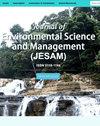Soil Phosphate Sorption Characteristics of Selected Calcareous Soil Series of Southern Punjab, Pakistan
IF 0.3
4区 环境科学与生态学
Q4 ENVIRONMENTAL SCIENCES
引用次数: 2
Abstract
To estimate the sorption and desorption capacity of some selected calcareous soils Jhatpat, Miani Pacca and Hadhwar from southern Punjab in Pakistan were analyzed. The sorption isotherms of the three soils yielded different curves. The maximum sorption was recorded in the Miani pacca soil series with value of sorption 201. 23 mg kg-1 which was followed by the Hadhwar series with peak sorption value of 190.04 mg kg-1. The lowest value for sorption was determined in the Jhatpat soil series. Comparing the different models (Langmuir, Freundlich and Temkin), Freundlich model showed good fit to the sorption isotherms with regression coefficient (R2) having value of 0.99, 0.99 and 0. 98 for Jhatpat, Miani pacca and Hadhwar soil series respectively, which was higher than the other two models used. The study on the effect of equilibration time (1, 10, 30 and 60 days) of applied inorganic Phosphatic fertilizers i.e. Single super phosphate (SSP) and diammonium phosphate (DAP) @ 60 and 120 kg ha-1 on two soil series with highest P sorption. The P sorption increased with increase in the time of equilibration, with higher value of extractable P was found 22.246 mg P kg-1 after 1 day of incubation, and it gradually decreased with the lowest value of 8.271 mg kg-1after 60 days of incubation.巴基斯坦旁遮普邦南部部分钙质土系对磷的吸附特性
为了估计巴基斯坦旁遮普省南部选定的一些钙质土壤Jhatpat、Miani Pacca和Hadhwar的吸附和解吸能力,对其进行了分析。三种土壤的吸附等温线产生了不同的曲线。最大吸附量记录在Miani pacca土壤系列中,吸附值为201。23 mg kg-1,随后是吸附峰值为190.04 mg kg-1的Hadhwar系列。Jhatpat土壤系列中确定了最低的吸附值。比较不同模型(Langmuir、Freundlich和Temkin),Freundlicch模型与吸附等温线拟合良好,回归系数(R2)分别为0.99、0.99和0。Jhatpat、Miani pacca和Hadhwar土壤系列分别为98,高于其他两个使用的模型。研究了在60和120 kg ha-1条件下施用无机磷肥(SSP)和磷酸二铵(DAP)对两个磷吸附量最高的土壤系列的平衡时间(1、10、30和60天)的影响。P的吸附量随着平衡时间的增加而增加,培养1天后可提取的P值较高,为22.246 mg P kg-1,培养60天后逐渐降低,最低值为8.271 mg kg-1。
本文章由计算机程序翻译,如有差异,请以英文原文为准。
求助全文
约1分钟内获得全文
求助全文
来源期刊

Journal of Environmental Science and Management
ENVIRONMENTAL SCIENCES-
CiteScore
0.90
自引率
0.00%
发文量
10
审稿时长
2 months
期刊介绍:
The Journal of Environmental Science and Management (JESAM) is an international scientific journal produced semi-annually by the University of the Philippines Los Baños (UPLB).
JESAM gives particular premium to manuscript submissions that employ integrated methods resulting to analyses that provide new insights in environmental science, particularly in the areas of:
environmental planning and management;
protected areas development, planning, and management;
community-based resources management;
environmental chemistry and toxicology;
environmental restoration;
social theory and environment; and
environmental security and management.
 求助内容:
求助内容: 应助结果提醒方式:
应助结果提醒方式:


